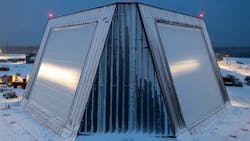Long-Range Radar Provides Distant Warning of Ballistic Threats
Timing was right to complete construction of the long-range discrimination radar (LRDR) by the U.S. Missile Defense Agency (MDA), the U.S. Northern Command, and the U.S. Space Force. The ceremony took place on December 7, 2021, at the Clear Space Force Station in Alaska. The multiple-mission LRDR system is design to track incoming ballistic missiles, combining the capabilities of lower- and higher-frequency radar systems. It can detect and track objects at a long distance using lower frequencies and discriminate among multiple detected objects by means of higher-frequency radar signals to sort among decoys and dangers. Ballistic missiles typically shed decoy and countermeasure materials along the way to confuse defensive measures. The LRDR system can help determine which are the targets for any missile defense system.
The impressive multiple-faced LRDR system (see the figure) has a 220° field of view and performs arrays that are 60 × 60 ft. This capability to sample the atmosphere arms the radar with the power to detect and track all classes of ballistic missiles and even hypersonic missiles and small objects. The LRDR’s detected signals increase the effectiveness of the missile defense system and help the U.S. Northern Command defend the country against even small and fast-moving threats.
U.S. Army Lt. Gen. A.C. Roper, the deputy commander of U.S. Northern Command, said: “For years, the Department of Defense has subscribed to a mindset of deterrence through punishment—taking advantage of our global response to execute retaliatory strikes.” Roper added: “It's a defense designed to give our potential adversaries pause. It is the type of deterrence that shifts cost-benefit calculus, providing doubt that an attack will be successful. And the LRDR helps to shift that calculus.” He told those responsible for designing and building the LRDR system that they are giving any potential adversaries pause for thought, having to deal at a distance with this powerful radar.
About the Author
Jack Browne
Technical Contributor
Jack Browne, Technical Contributor, has worked in technical publishing for over 30 years. He managed the content and production of three technical journals while at the American Institute of Physics, including Medical Physics and the Journal of Vacuum Science & Technology. He has been a Publisher and Editor for Penton Media, started the firm’s Wireless Symposium & Exhibition trade show in 1993, and currently serves as Technical Contributor for that company's Microwaves & RF magazine. Browne, who holds a BS in Mathematics from City College of New York and BA degrees in English and Philosophy from Fordham University, is a member of the IEEE.
